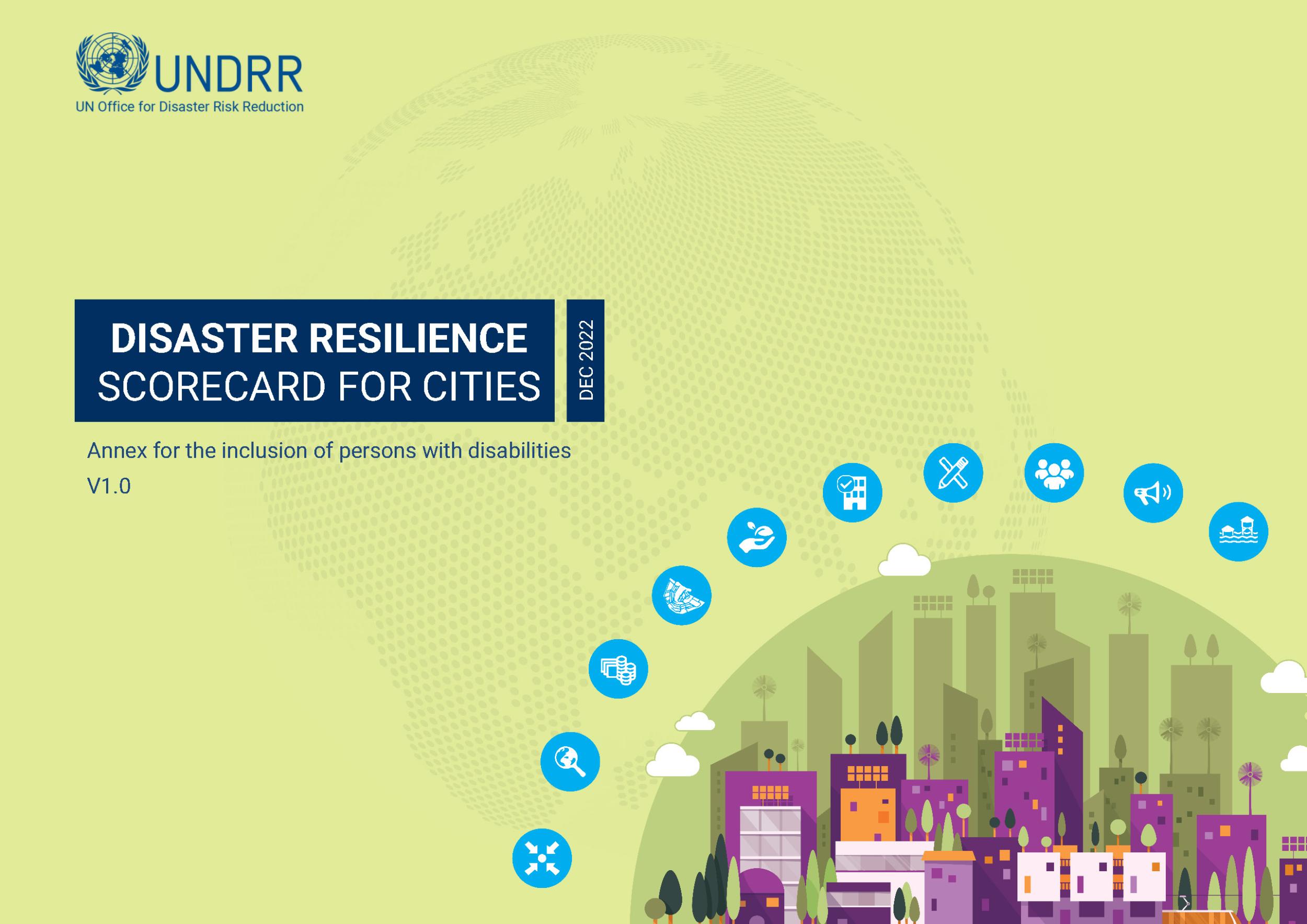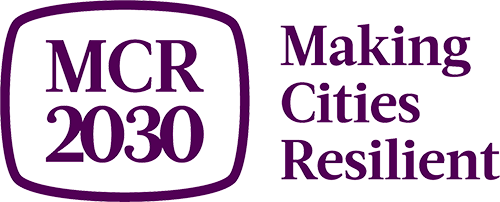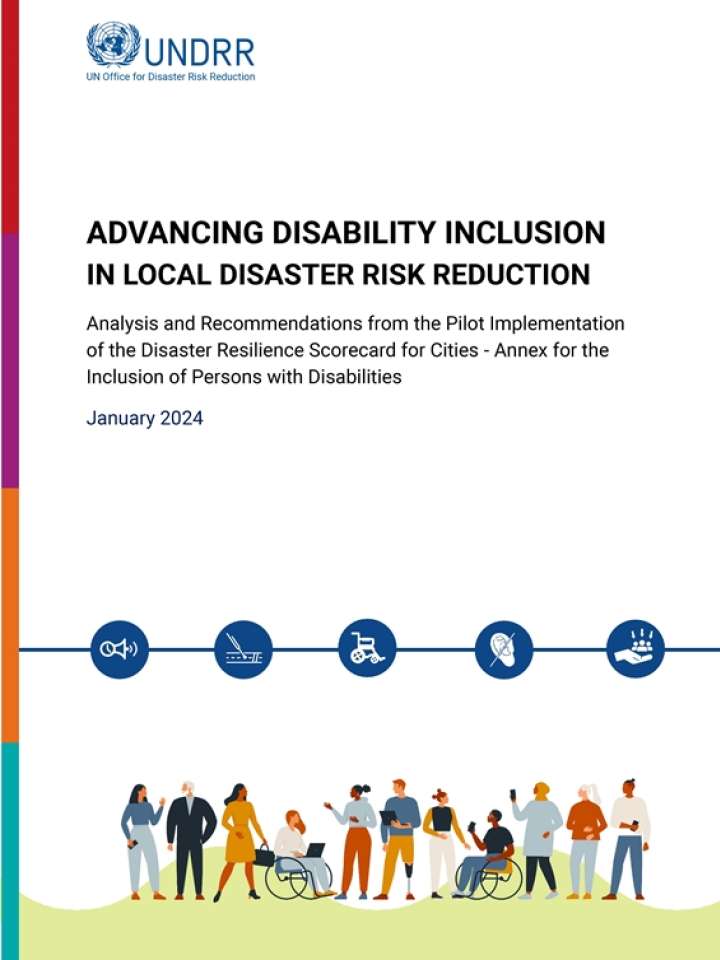Disaster Resilience Scorecard for Cities – Annex for Inclusion of Persons with Disability

Annex for the Inclusion of Persons with Disabilities
This Annex for the Inclusion of Persons with Disabilities has been developed as a complement to the City Scorecard and supports the assessment of local government capabilities to design, formulate and implement policies for the inclusion of persons with disabilities in disaster risk reduction. It incorporates persons with disabilities as an integral part of the development of these local strategies, with a view to strengthening cities that are increasingly resilient and inclusive with regards to disaster risk. It responds to the call of UN Secretary-General Antonio Guterres who, with the adoption of the UN Disability Inclusion Strategy in June 2019, noted that the inclusion of persons with disabilities is central to the achievement of the 2030 Agenda for Sustainable Development, and that when we remove policies or biases or obstacles to opportunity for persons with disabilities, the whole world benefits.
It includes specific criteria on considerations for the inclusion of persons with disabilities for each of the Ten Essentials for Making Cities Resilient that were designed to support the implementation of the Sendai Framework for Disaster Risk Reduction at the local level. Together with two crosscutting principles, close consultation with and active involvement of persons with disabilities through their representative organizations and accessibility, the present Annex seeks to broaden the scope of the Scorecard process and support the formulation of local strategies and plans for enhancing more resilient and inclusive cities.
Scope
This Annex for the Inclusion of Persons with Disabilities should be used in conjunction with the Disaster Resilience Scorecard for Cities. It aims to promote inclusion and accessibility in the urban environment, so that no person with a disability be left behind. As such, the adaptations suggested here are in keeping with the 7 principles of universal design (Equitable Use, Flexibility in Use, Simple and Intuitive Use, Perceptible Information, Tolerance for Error, Low Physical Effort and Size and Space for Approach and Use). While the principles of inclusion are broad, this document is based on the guiding principles with regards to the role of “stakeholders” as outlined in the Sendai Framework for Disaster Risk Reduction 2015-2030. For the purposes at hand, the starting point for the implementation of this Annex is a focus on persons with disabilities, understanding that their needs are differentiated, and that being inclusive requires particular attention to ensure that such differentiated needs and contributions are considered fully.
There are a total of 19 questions/indicators, each with a score of 0-3, where 3 is the maximum possible score.
It is recommended for use in a half to full day multi-stakeholder workshop.
This addendum is available in different file formats:
- The PDF version contains assessment details in a printing-friendly format.
- The Accessible PDF version is made to allow universal access to the document.
- The excel tool allows you to provide interactive scoring, take note of the assessment rationale, and provide proof for verification. The excel tool can produce the pictograms showing the results of analysis at the end which are highly useful for planning and decision making. It complements the narrative provided in the PDF version.
Download Scorecard
Select your language:
English
- Disability Inclusion Scorecard v1.0 (PDF)
- Disability Inclusion Scorecard v1.0 - accessible (PDF)
- Disability Inclusion Scorecard v1.0 (Excel Tool)
Arabic
- Disability Inclusion Scorecard v1.0 (PDF)
- Disability Inclusion Scorecard v1.0 - accessible (PDF)
- Disability Inclusion Scorecard v1.0 (Excel Tool)
Chinese
- Disability Inclusion Scorecard v1.0 (PDF)
- Disability Inclusion Scorecard v1.0 - accessible (PDF)
- Disability Inclusion Scorecard v1.0 (Excel Tool)
French
- Disability Inclusion Scorecard v1.0 (PDF)
- Disability Inclusion Scorecard v1.0 - accessible (PDF)
- Disability Inclusion Scorecard v1.0 (Excel Tool)
Indonesian (Bahasa)
- Disability Inclusion Scorecard v1.0 - accessible (PDF)
- Disability Inclusion Scorecard v1.0 (Excel Tool)
Portuguese(BR)
- Disability Inclusion Scorecard v1.0 (PDF)
- Disability Inclusion Scorecard v1.0 - accessible (PDF)
- Disability Inclusion Scorecard v1.0 (Excel Tool)
Russian
- Disability Inclusion Scorecard v1.0 (PDF)
- Disability Inclusion Scorecard v1.0 - accessible (PDF)
- Disability Inclusion Scorecard v1.0 (Excel Tool)


